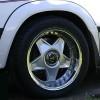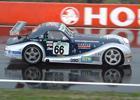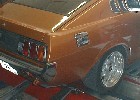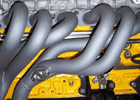| Author | Topic |
|---|

Location:
Adelaide and Queenstown T...
Registered:
September 2002
|
|
Negative Supercharging
|
 Thu, 27 February 2003 02:38
Thu, 27 February 2003 02:38

|
 |
The inventor of this has offered a prototype to work on a 2T-C for a project group at uni, I am trying to convince them that a 18R engine would be better and have a bigger market but anyway here is the info, tell me what you think and if you think there is a market and i will give the guy some feedback. I think this would be ideal for old celica's etc if the design actually works.
HOW NEGATIVE SUPERCHARGING WORKS
Negative Supercharging is a highly advanced and complex Thermo Fluid Dynamic Process that converts the positive exhaust pressure produced after combustion into "Negative Boost" within the cylinders to pull more air into the engine.
Negative Supercharging does NOT use any type of blower device and works the opposite to conventional supercharging by pulling air into the engine instead of pushing air like conventional superchargers and turbochargers. The best way to understand Negative Supercharging is to imagine you are reading about how
engines work for the first time, otherwise you will never get it.
Negative Supercharging is:
1. Produced by the Impulse Tri-Y Header/Collector
2. Controlled by the 8 Key Combination of the Impulse Camshaft and Cylinder Head
3. Enhanced by Thermodynamics and Hot Air Induction
Impulse Tri-Y Header/Collector
Negative (low) pressure is naturally produced behind all moving objects which travel at a high speed. Negative Supercharging uses this negative pressure to supercharge the engine.
The Negative Supercharging process works as follows:
1. After combustion approximately 300psi of positive pressure remain in the cylinder.
2. When the exhaust valve opens the high pressure in the cylinder forces itself out the exhaust port and into the very small primary pipe of the Impulse Tri-Y Header.
3. As this high pressure gas is forced through the small primary pipe of the Impulse Tri-Y Header, it is compressed and accelerated to a high velocity which is twice the speed produced by conventional Headers. However, compressed gas
will only remain compressed for a short distance before backpressure becomes excessive and restricts the gas flow. For this reason the length of the primary pipe of the Impulse Tri-Y Header is very short. Also, by adding a megaphone pipe after the small primary pipe, it allows the compressed gas to gradually expand into the larger diameter of the megaphone pipe. This eliminates backpressure and produces a very fast moving column of compressed gas in the primary pipe.
4. The column of compressed gas in the primary pipe is moving at such high speed a negative pressure is naturally formed behind it. This negative pressure is similar to the slipstream effect produced behind a race car travelling at high speed which is strong enough to pull along another race car travelling
close behind.
5. The negative pressure produced behind the fast moving column of compressed gas in the primary pipe is so powerful it reduces the pressure in the cylinder at the end of the exhaust stroke. This works beyond exhaust scavenging which is able to only purge the exhaust gases from the cylinder and is not strong enough to reduce cylinder pressure because, 1) the gas speed in conventional headers is too slow, 2) the negative pressure behind the column of gas in the primary pipe is too weak, 3) the length of the primary pipe is too long and 4) the diameter of the primary pipe is too large.
6. By closing the exhaust valve early and synchronising 8 key areas of the Cam and Cylinder Head which control the air and gas flow, the negative pressure is trapped in the combustion chamber during the overlap period. (See below 8 Key
Combination).
7. When the intake valve opens the negative pressure which is trapped in the combustion chamber, pulls air into the cylinder BEFORE the piston begins the intake stroke. By reducing the pressure in the combustion chamber a "Negative Boost" effect is produced in the cylinder which is used to supercharge the engine before the piston begins to reduce cylinder pressure to pull air into the engine during the intake stroke.
8. The maximum supercharging effect produced by the Negative Supercharging process is determined by how much of the positive combustion pressure during the exhaust stroke is converted into "Negative Boost" and is trapped in the combustion chamber during the overlap period. (See below why the Impulse Tri-Y
Header/Collector can not be used alone).
8 Key Combination
To control the Negative Supercharging process, it requires:
A. Using the Impulse Valve Timing which features earlier opening and closing of the valves, less exhaust duration, less exhaust valve lift and less overlap duration in 8 key areas of the camshaft and cylinder head. For example,
1) Intake Valve Closes 10° Earlier
2) Exhaust Valve Closes 12° Earlier
3) Exhaust Valve Opens 8° Later
4) Exhaust Valve Lift .150" Lower
5) Exhaust Duration 8° Less
6) Exhaust Gas Speed 70% Faster
7) Overlap Duration 10° Less
8) Overlap Flow Critical
AND
B. Synchronising the above 8 key areas to work together to trap the "Negative Boost" in the combustion chamber during the overlap period. For example, the Negative Supercharging process is so highly complex, if one of the 8 key points which controls this process is moved from the optimum position, each one of the
other 7 key points must be moved a critical amount and in a critical direction for Negative Supercharging to work. This makes it very difficult and expensive to figure out the optimum specifications of Negative Supercharging for each different application without the blueprints.
Also, the "Negative Boost" can be increased to produce more torque and horsepower by creating a higher gas speed in the Impulse Tri-Y Header or opening the exhaust valve earlier. This requires Negative Supercharging to use less overlap duration and less overlap flow the greater the "Negative Boost"
and the higher the rpm which is the opposite requirements to conventional engines. However, this alters the synchronised timing of the 8 key combination which prevents the Negative Supercharging process from working unless all 8 areas of the cam and cylinder head which control the air and gas flow (fluid
dynamics) are re-synchronised to trap the higher Negative Boost in the combustion chamber during the overlap period. This also makes it very difficult and expensive to figure out the optimum specifications of Negative Supercharging without the blueprints.
Thermodynamics and Hot Air Induction
The Negative Supercharging process also requires a hot air induction temperature between 43-50°C (110-120°F) and a cold water temperature below 50°C (120°F) to maintain the critical combustion temperature which is needed to optimise performance. When hot gas is ignited in the combustion chamber it expands with much greater force and at a faster speed than cold gas, which:
1. Increases the cylinder pressure to produce more power with the same volume of air in the cylinder. This is possible because the increase in power produced by faster combustion is much greater than the loss produced by the less dense hot air
2. Vapourises more of the liquid fuel into a gas which requires less fuel to produce the same power
3. Requires a special ignition advance curve to optimise the power produced by the higher cylinder pressure and to prevent pre-ignition, and
4. Transfers less heat into the cooling system which makes the engine run much cooler
These are the opposite requirements to conventional engines which use a hot water temperature between 82-100°C (180-210°F) and cold air induction to produce the optimum combustion temperature needed to maximise power. However, when the air temperature increases in conventional engines during hot weather
so does combustion and water temperatures which dramatically reduces power. On top of this, the speed of combustion in conventional engines is very slow which transfers more heat into the cooling system and makes the engine more likely to
overheat during hot weather. These problems are eliminated with hot air induction when it is used in conjunction with a cold water temperature, fast combustion and the Negative Supercharging process.
Impulse Tri-Y Header/Collector Can Not be Used Alone
The Impulse Tri-Y Header/Collector combines 5 exhaust pipe technologies into one:
1. Tri-Y Header design
2. Small Pipe design
3. Megaphone design
4. Stepped Pipe design
5. Short Pipe design
This combination creates a compact 14" long small diameter Tri-Y Header and a compact 24" long small diameter megaphone collector which produces "Negative Boost" that is so powerful, the Impulse Header will pull most of the air/fuel mixture during the overlap period into the exhaust system in a conventional engine with standard valve timing. This will cause the engine to lose all power and the exhaust system will glow red hot which may create a fire or damage the engine. For this reason, each Negative Supercharging Kit will have a "Warning"
plate on the exhaust header which informs the customer that the Impulse Tri-Y Header/Collector must NOT be used on the engine without the Impulse Camshaft and Valve Timing.
Negative Supercharging is a Complex Process that Requires a Simple Engine Design Negative Supercharging is a lot more like computers than today's mechanically complex engines. Like computers, Negative Supercharging looks simple on the outside but is hi-tech and complex in the way it works on the inside. Whereas todays engines look very complex on the outside but are actually low-tech and simple in the way they work on the inside. The reason for this is that today's engines are still using the same low-tech and outdated fluid dynamic process
used by the primitive engine designs from the 18th Century but with 100 years of refinement.
Negative Supercharging uses a new hi-tech fluid dynamic process from the 21st Century to supercharge the engine but it requires a mechanically simple and low cost engine design for this new supercharging process to work efficiently and optimise performance. Complex and expensive parts used on today's engines are not required with Negative Supercharging. A good example is engines with 4 valves per cylinder which prevent the Negative Supercharging process from working unless one of the two exhaust valves are permanently closed.
The Negative Supercharging process can tranform a mechanically simple engine into a hi-tech Torque Monster that produces twice the power of today's mechanically complex engines. Therefore, developing engines with more mechanical complexity is a nice hobby for the rich, but is not a practical solution to making hi-performance engines affordable in the future for the general population.
[Updated on: Thu, 27 February 2003 02:41]
|
|
|

Location:
Brisbane
Registered:
May 2002
|
|
Re: Negative Supercharging
|
 Thu, 27 February 2003 03:38
Thu, 27 February 2003 03:38
 
|
 |
This tripe has been around for ages now. This guy is basically trying to sell the concept of tuned exhaust systems as his own invention, hoping no-one will realise it has been well known and well used for decades. He has about the same amount of credibility as the guy who invented the TurboZet.
|
|
|

Registered:
May 2002
|
|
Re: Negative Supercharging
|
 Thu, 27 February 2003 05:58
Thu, 27 February 2003 05:58
 
|
 |
C'mon fella's!! Hands up who bought a TurboZet!!
I must admit, before I knew anything, I was tempted!
|
|
|

Location:
Finland
Registered:
November 2002
|
|
Re: Negative Supercharging
|
 Thu, 27 February 2003 11:17
Thu, 27 February 2003 11:17
 
|
 |
What was the TurboZet was it something like those electric superchargers. Equally efficient anyway, right?
And RA28midge hows the dynomap?
|
|
|

Location:
Madrid - Spain
Registered:
August 2002
|
|
Re: Negative Supercharging
|
 Fri, 28 February 2003 03:38
Fri, 28 February 2003 03:38
 
|
 |
Sounds interesting, however there is a few holes in the theory. Firstly - The whole idea of using a mechanically simple engine is a crock of  because you cannot get a conventional valve system to work at the speeds required to make this thing work. because you cannot get a conventional valve system to work at the speeds required to make this thing work.
Secondly - You are going to have to come up with a pretty special fuel to make it work, because you can't have any valve overlap that works fantastically well for normal high octane fuel.
The laws of thermodynamics are impressive when looked at like this but a conventional engine is a mechanical device and has limitations, particularly inertia. It sounds great in concept, but a fail to see how it could even make as much power as a normal natrually aspirated engine.
My two cents worth anyway.
|
|
|
|
|
Re: Negative Supercharging
|
 Fri, 28 February 2003 05:12
Fri, 28 February 2003 05:12
 
|
 |
i fail to see how this could serve to incresae the amount of air in the cylinder anyway.
no matter what the vaccuum in the cylinder, it can only fill to atmospheric pressure anyway without some pressure at the intake side.
Sounds like fancy tuned headers to me.
not compareable any sort of forced induction.
Matt
|
|
|

Location:
Montrose, VIC
Registered:
May 2002
|
|
Re: Negative Supercharging
|
 Fri, 28 February 2003 06:49
Fri, 28 February 2003 06:49
 
|
 |
Sounds a lot like a well made exhaust to me... and that's something that should always be done!
As for negative pressure, well you can assist scavenging slightly by using a cam with suitable overlap to allow fresh air to be pulled out the exhaust as well, but the trick is to use direct injection to avoid pulling fuel out too...
Anyone ever studied that GM diesel engine?
|
|
|
Location:
Hornsby, Sydney
Registered:
October 2002
|
|
Re: Negative Supercharging
|
 Sun, 02 March 2003 03:04
Sun, 02 March 2003 03:04
 
|
 |
|
I've seen this about 3 years ago or so and it was ready and up for sale.
|
|
|

Location:
Adelaide and Queenstown T...
Registered:
September 2002
|
|
Re: Negative Supercharging
|
 Tue, 04 March 2003 03:28
Tue, 04 March 2003 03:28
 
|
 |
I was expecting that response, The guys at uni are getting all excited over the concept but I was a bit sceptical, but I had hoped that it would have been at least half as good as what the guy was building it up to be. I guess they will at least get their thesis out of it and I will let you know if there is any actual difference when they dyno it at the end of the year.
Cheers Lads
|
|
|

Location:
Lost in the K hole
Registered:
May 2002
|
|
Re: Negative Supercharging
|
 Tue, 04 March 2003 03:38
Tue, 04 March 2003 03:38
 
|
 |
| Yojimbo wrote on Fri, 28 February 2003 16:12 |
no matter what the vaccuum in the cylinder, it can only fill to atmospheric pressure anyway without some pressure at the intake side.
|
not entirely correct, you can pressurise the cyl at atmospheric pressure using finely tuned intake harmonics. at certain rpms etc, you can get high energy standing waves develloped in the intake runners that, when tuned correctly, can pressurise the cyl above atmospheric pressure.
you can get say 115% volumetric efficiency using this method.
|
|
|
|
|
Re: Negative Supercharging
|
 Tue, 04 March 2003 04:28
Tue, 04 March 2003 04:28
 
|
 |
but this system says nothing of intake harmonics only vaccuum on the exhaust side.
If such harmonics caused a positive pressure effect ( and I'm not saying they could not) then to me that would count as a form of forced induction ie. positive pressure is being produced on the intake side, b4 the cylinder.
Matt
|
|
|

Location:
Lost in the K hole
Registered:
May 2002
|
|
Re: Negative Supercharging
|
 Tue, 04 March 2003 04:37
Tue, 04 March 2003 04:37

|
 |
actually, thats an interesting consideration.
have these guys considered any potential destructive wave interference that may occur during valve overlap, between the exhaust 'vacuum' pulse, and the corresponding pressure waves in the intake runners?
they might find that a vacumm acting at the ex valve, may interfere out of phase with the harmonics of the intake runners at certain rpms - that'd really screw the system around!
ed
|
|
|